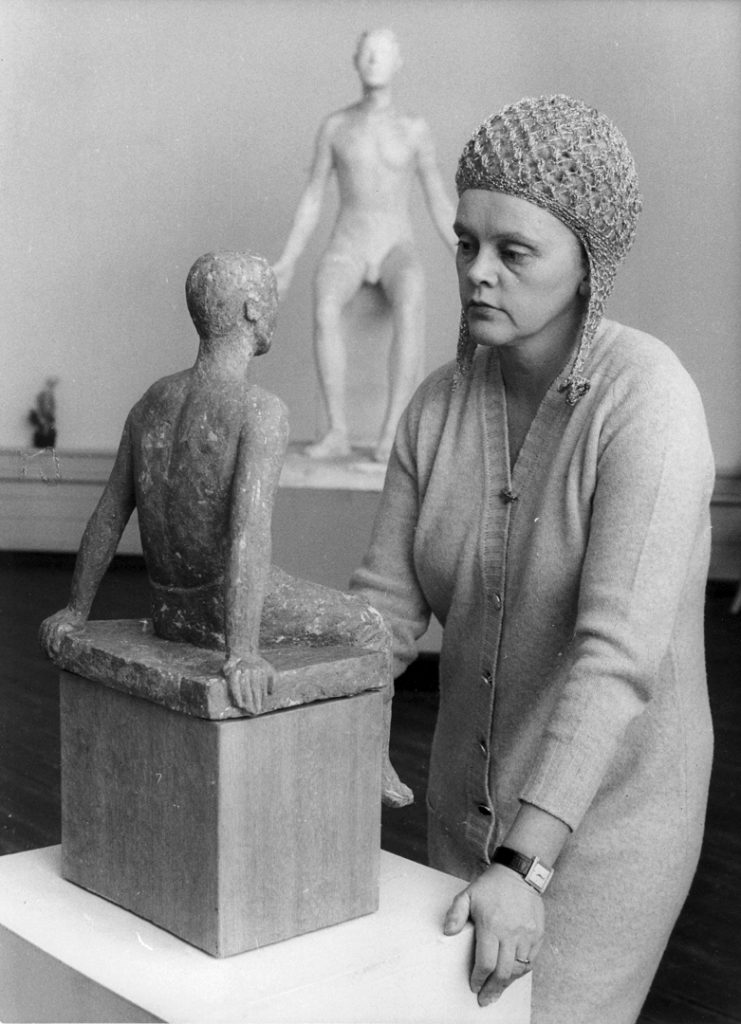
Ólöf Pálsdóttir (1920-2018) was born into a highly artistic and literary family, and already at an early age she decided she wanted to be a sculptress.
At the start of the Second World War she sailed to the Faroe Islands to be with her father. Unable to leave the country for three years, she used the time to pursue her education in the arts. In 1945 she moved to Denmark where she studied at a private art academy in Aarhus. Subsequently she moved to Copenhagen where she took a foundation course at Fredriksbergs Tekniske Skole.
In 1949 she entered the Royal Danish Academy of Fine Arts where she studied sculpture under Einar Utzon-Frank, one of Denmark’s best-known sculptors at the time. She also attended lectures given by the realist painter and engraver Aksel Jørgensen. Ólöf felt at ease among her classmates who were penniless students, aristocrats and foreigners, and she excelled in her subject. In 1952 her work drew special attention at the academy’s end of year exhibition. Ólöf travelled far and wide during her lifetime, and in 1954 she had the opportunity to visit Egypt. There she studied sculpture under the guidance of Wissa Wassef, a renowned professor of art and architecture. She also used her time in Egypt to acquaint herself with the ancient cultural legacy of that country. The Royal Academy in Copenhagen awarded Ólöf the gold medal for her graduation piece, the sculpture: Son. In 1957 she travelled to Rome to continue her studies under Professor Fazzini.
Soon after finishing her education, Ólöf married Sigurður Bjarnason, editor of Morgunblaðið, and member of parliament, and settled in Iceland. Ólöf admitted she had doubts about whether marriage and motherhood were compatible with her career as a sculptress, and her misgivings turned out to be somewhat justified. In those days, for women to give up their careers and devote time to being housewives and rearing children was considered the norm. However, Ólöf went against the grain, using every spare moment to continue sculpting at her studio on Vesturgata, in Reykjavík’s old quarter. One of the pieces she produced there was her bust of author Halldór Laxness, commissioned by publisher Ragnar Jónsson. She also gave classes at the Icelandic School of Arts and Crafts, imparting her knowledge and skills to a new generation.

In 1970, Ólöf’s husband was appointed Icelandic Ambassador to Denmark, and the couple moved to Copenhagen. Later, he took up another appointment as Ambassador to the United Kingdom and Nigeria, and they moved to London. They returned to Iceland in 1982. Ólöf always maintained that her job as ambassadress gave her little time or space in which to pursue her art, and yet she strove to promote Icelandic culture in the countries where she and her husband was posted, organising exhibitions and concerts, giving talks on various aspects of the country’s culture as well as writing articles for newspapers and magazines.
Ólöf’s first solo exhibition was held in 1961 at the Faroese Arts Society during Ólafsvaka, at Torshavn in the Faroe Islands, where she had spent most of the Second World War. Later she would have solo exhibitions in Denmark and the UK, as well as taking part in numerous group exhibitions both in Iceland and abroad. She was a member and co-founder of the pan-Scandinavian art group Den Nordiske, among others, and in 1989 was made an honorary member of the Royal Society of British Sculptors.
The human form was Ólöf’s principal subject, both busts and full figures, which she sculpted mainly in clay or plaster. Numerous of her pieces have been cast in bronze. Her work is naturalistic in spirit, visually beautiful, and at the same time expressive in a way that reveals the artist’s engagement with the inner life of her subject. Her Figure of a Girl (Soffia) from 1950 that ornaments the gardens at Kvennaskólin in Reykjavík is a study of childlike innocence and sincerity. Her best known work The Musician dates from 1974. The Danish-Icelandic cellist Erling Blöndal Bengtsson famously played his instrument while he sat for Ólöf. This simple yet powerful sculpture has transformed the musician into a timeless symbol of his art. The Musician now stands majestically outside Reykjavík’s main concert hall Harpa and, as with Ólöf’s other works, the piece displays a commanding sense of form, as well as revealing the uniqueness of her expression and artistry.
Kristín G. Guðnadóttir
Art Historian
From the category About Ólöf, in the Archive